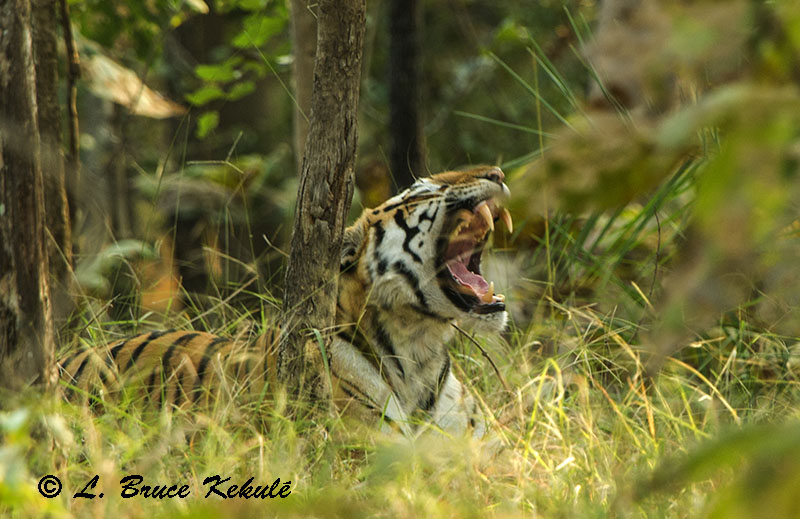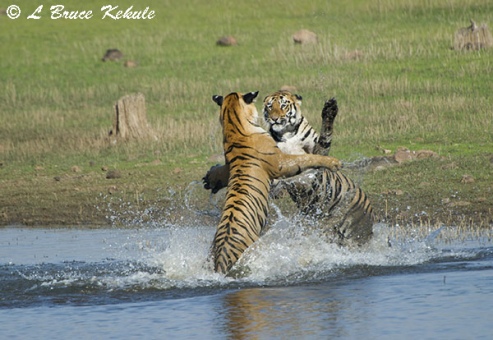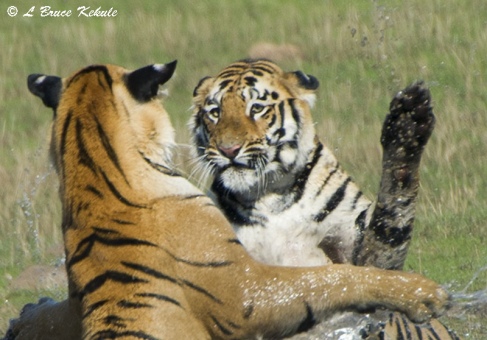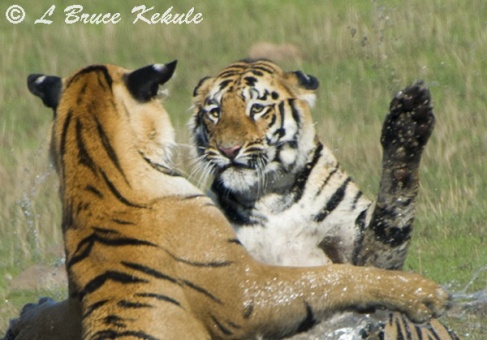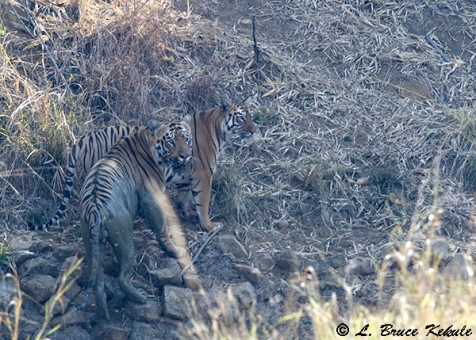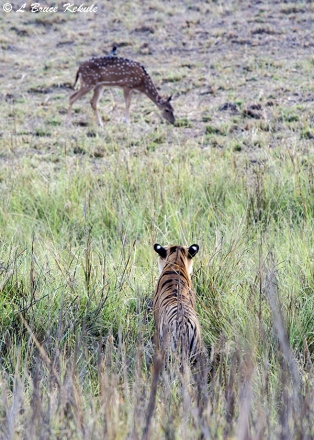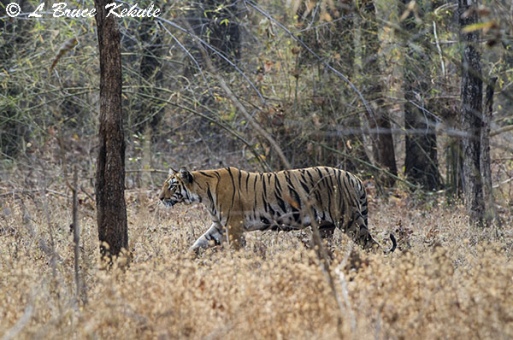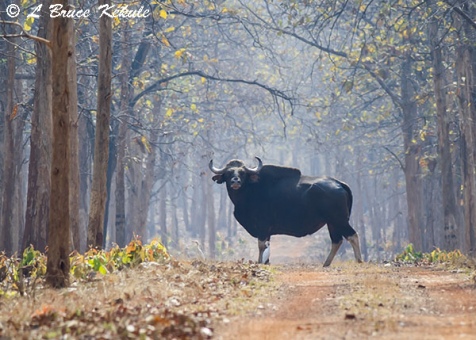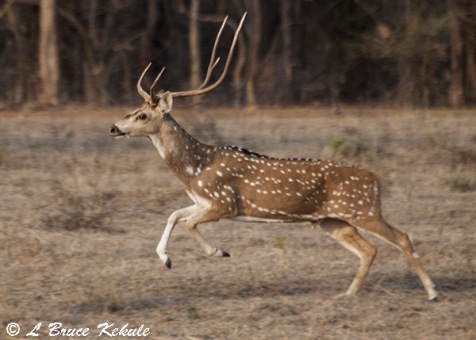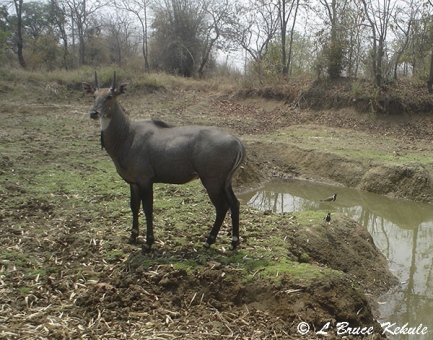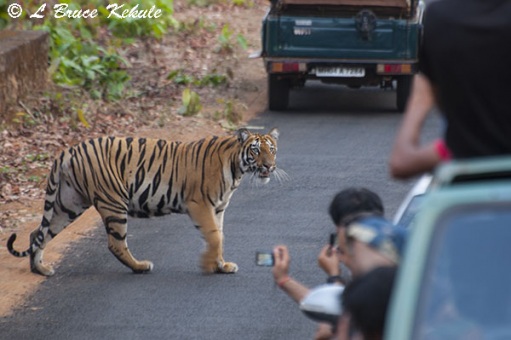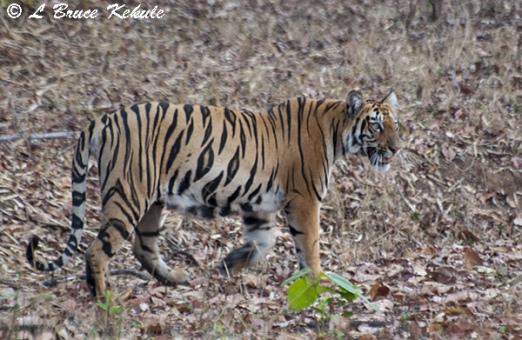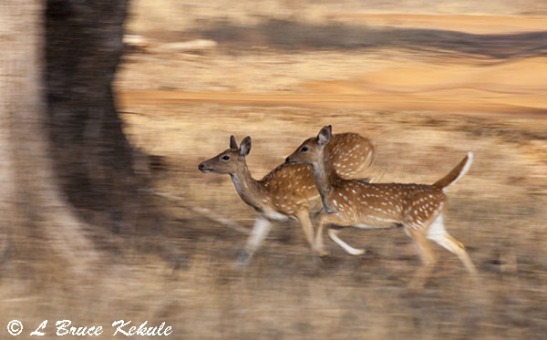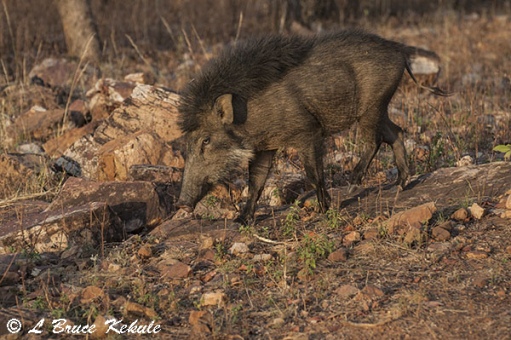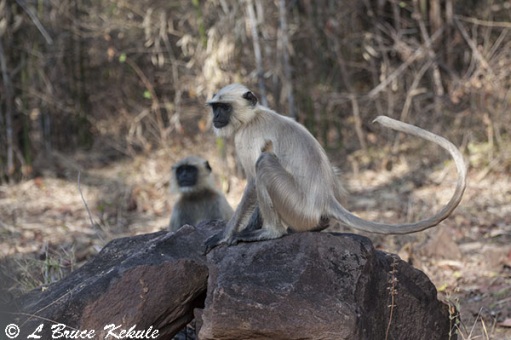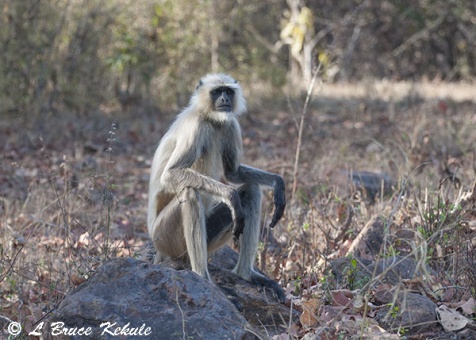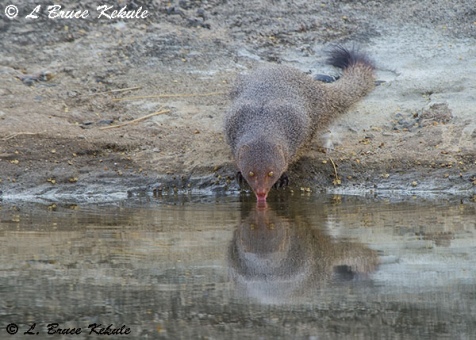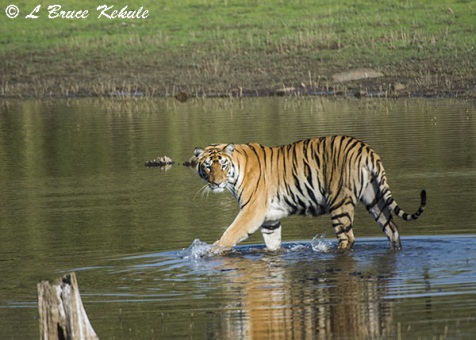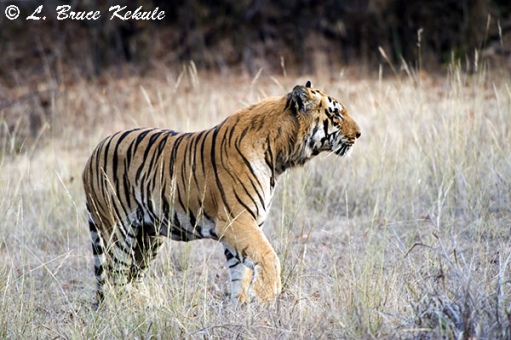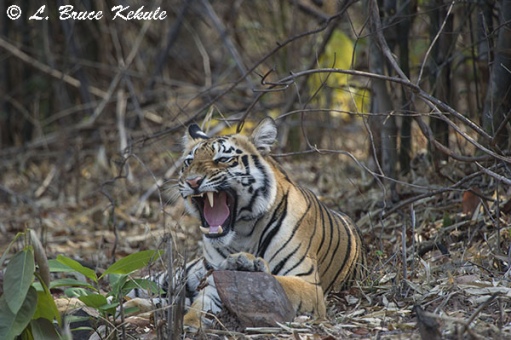Posts Tagged ‘predators’
Pench Tiger Reserve: A fantastic trip with a close friend…!
An amazing forest in India’s Madhya Pradesh with some truly beautiful tigers…!
Collarwali on her way to the Pench River for an early morning drink…!
Being at the right place and right time always works. I arrived at the Tulie Tiger Corridor Resort close to Pench Tiger Reserve in the late evening of April 2nd and was greeted by my very good friend and naturalist, Omeer (Omi) Choudhary. As it was late and I was totally bushed from a long haul (airline flight from Ahmedabad in Gujarat visiting the Blackbuck-Velavadar National Park, and then a grueling 3-hour taxi ride from Nagpur), it was straight to bed for an early start the next morning.
Collarwali the next morning yawning after a long sleep…!
Up at five and after quick coffee and gate formalities, we entered the park at 6am and drove to the other side of the park (one hour drive) where the famous female tiger ‘Collarwali’ of Pench and her two cubs were being seen. That morning, I got a glimpse of ‘stripes in the grass’ and that was that. In the afternoon, one of her cubs was lying in the dense bush and I was able to get some good shots.
One of Collarwali cubs resting in the afternoon…!
The next morning however as we were sitting in the jeep waiting on some action, ‘Collarwali’ step out in front of us and walked down to the Pench River. It was great to see her again in lovely morning light. She is one of my favorite tigers in India…!
Collarwali’s other cub with mother in the back…!
The next morning and final day of my safari, I paid respects to the ‘Spirit of the Banyan Tree’ with a coconut and some joss sticks at the gate. After a 40-minute drive (short-cut), we found ‘Collarwali’ sleeping with a cub on a big rock and I got both of them together but at distance.
Raiyakassa, the dominant male tiger walking past the jeep all muddied up from a snooze in the big pond…!
In the afternoon very near closing time, we bumped into a leopard (rare for Pench) and I got a few shots. Then, as we were motoring back to the lodge just before the deadline of 6:30pm, we bumped into the dominant male (Collarwali’s mate Raiyakassa) walking towards us from the big pond. He was half covered in mud but still a magnificent creature and I was able to get a bunch of great images as he walked very close to our jeep. It was that good old ‘right time and right place’ and the ‘Spirit of the Banyan Tree’. What a fitting end to my second trip to Pench and I would like to thank Omi for his wonderful spirit and friendship…I will miss him..!
Raiyakassa caught head on…he is truly a beautiful male tiger and father of many of Collarwali’s cubs (22 cubs-6 litters)…!
As most people know now, Pench recently lost the Baghin Nala female and two of her cubs to poisoning on March 28th. This is very unfortunate for the park, Forest Department and people who love to see tigers. Fortunately, the other two cubs were saved and shifted to Kanha as they surely would have died too. It could take sometime for another big cat to fill this void and the danger will still be there of future poisonings.
On a good note, some of the poachers involved in this case have been apprehended and the others are being sought after. This incident plus others (27 tigers killed by poisoning and other circumstances in India since the Jan. 1st) is a growing trend and the ruthless Chinese tiger bone medicine devils are behind this. Somehow it must be stopped now or more tigers will be lost to this mindless draconian practice…!!
The Forests of Madhya Pradesh in India – Part Three
Pench National Park and Tiger Reserve
‘Collarwali’ and jackal…the little dog was faster and got away…she is old and has sired 22 cubs…but she still has class…!
In November, the weather is nice and crisp in the morning, as the winter season has just begun in Central India. When entering the forests in an open jeep, it becomes quite chilly first thing and a few layers of warm clothing are imperative. Then as the safari progresses and the sun climbs into the sky, it becomes warmer and those layers are pealed off. It’s a great time to be in the forests of Madhya Pradesh.
‘Collarwali’ on the run after the jackal…!
My time was up in Kanha, and I moved further southwest to the next great tiger reserve named Pench National Park and Tiger Reserve encompassing some 758 sq. kilometers. The taxi ride takes about three hours but is still stressful as is any two-lane highway in India. But again, I arrived in safety at the ‘Tuli Tiger Corridor’ lodge about 15 minutes from the main gate into the reserve.
‘Collarwali’ checking scent marking…!
That night before dinner, my naturalist Omveer Choudary gave me a run-down on what was going on in Pench. There was a female tiger with four cubs hanging around near the road and that our chances of seeing her was good. Also, the most famous female tiger in Pench named ‘Collarwali’ (a mother of 22 cubs) was also around. She was named because she has worn a collar for many years and the thing doesn’t even work now, but the authorities are worried about darting her with cubs and so have left it on. He said our chances were very good and this was coming from a guy who is a top-notch naturalist and driver for 12 years of experience here in Pench (he’s the boss). I was convinced.
The last time I saw ‘Collarwali’…she’s a magnificent big cat…!
The next morning after a quick cup of coffee and some crackers and cookies (standard breakfast fare while on safari in India), we jumped into the jeep at around 5am but it was not as cold as the other two tiger reserves I had just been to. We were the first in line at the gate, which was a good sign. I walked over to a ‘banyan’ tree close-by and wished for good luck. We entered but as the morning wore on, it looked like it would come-up dry.
My first tiger in Pench: She was the female with 4-cubs and it was a tight scene…!
Then, as we were more or less heading back for lunch, we bumped into a large group of jeeps parked on the road, and ‘Ome’ said, “it’s a tiger”. And there she was; the female with 4-cubs about 50 meters away from the road lying down in foliage and just her head showing. I just got glimpses of the cubs. I put a 1.7X tele-converter on my 200-400mm VRII lens to get a closer look and ripped off a bunch of shots.
Three-fanged tigress in the afternoon. She was the same tiger as in morning…!
That afternoon, we bumped into her again at another location close-by but she was still resting with her right side showing this time. Her left lower-fangs is broken. She eventually woke-up and my D3s did not stop shooting when she showed.
A sub-adult male tiger the 2nd morning…lady luck was talking…!
The next morning, we saw a sub-adult male lying down more than 50 meters away. Pench was becoming a favorite after two tigers in two days. Day three was good for other species like sambar, wild dog and jackal. And on day four at 6am in the morning we took a left turn at a junction several kilometers from the gate and all the other jeeps went straight. Around the corner and there she was: Collarwali standing in the road looking at us. Then she started walking towards us. She had her eyes on a jackal and actually chased after one but it was too quick for her. ‘Ome’ backed-up and she did not stop passing us out near the main road junction.
We followed her but the crowds began to show-up so we bugged-out. I had already got a bunch of nice shots of the most famous tigress there. I have no idea, but I really liked Pench and vowed to return again in 2016; and that is the plan for now. Jeep numbers are controlled and it is not too bad in the park like some of the other tiger reserves where it becomes a madhouse around a tiger.
Many thanks to all the staff at Tuli Tiger Corridor lodge and I would especially like to thank Omveer Choudary, my naturalist for a great time and passing on his wonderful knowledge, and to the Pench Forest Department.
Next and last stop on my journey: Satpura National Park and Tiger Reserve – where a monster croc lives…!
Tiger Stripes: Identify individual tigers by their stripes and markings
Nature has provided an interesting concept of identifying individuals by certain patterns like tiger stripes, or even human fingerprints for that matter. There are no two individuals alike so one can recognize the same subject in several photographs if the angle is right. I was able to pick-out the same tiger in two photos taken more than a week apart.
Two tiger cubs sparring in the lake at Tadoba.
As most of you know, I recently went to India and photographed some extremely interesting tigers in Tadoba Andhari Tiger Reserve in central India. It was an exciting trip and I got many photographs of the striped predator including jumping tigers in the lake, and close-up roadside portraits plus many more. The cats here pay no attention to the vehicles most of the time and hence, photos are pretty straightforward with the right equipment, right techniques, right timing and some luck I guess.
Tigers sparring up-close.
On the second morning of my safari, a pair of young tiger cubs entered the shallow lake for some fun and cooling off in the morning sun. I had my Nikon D3s and a 200-400mm VRII lens with a 2X converter for 800mm on a monopod and when the action began, I was ready catching the two in mid-air. This shot is probably one of my best ever photographs as a wildlife photographer.
Tiger cub posing by side of the road
Later in the safari near the end, I caught a tiger posing by the side of the road. This female cub is almost mature and about ready to leave the care of her mother and father. She has been roaming by herself more and more recently.
Tiger posing up-close: Note stripe on left cheek.
In the late afternoon on the next to the last day, a whole bunch of jeeps or ‘Gypsies’ as they are called in India were parked waiting on a sleeping tiger. We could not carry-on because the drivers had plugged-up the road so we also parked and waited.
After awhile, a cub got up from her slumber in the bush on the left and crossed the road in front of us. She walked between the cars and an Indian forest official, and then came over to the right side of our jeep and plopped down with her left front paw resting on a rock. I got many photos and some great portraits with loads of behavior and flashing canines.
Imagine my surprise when going through my photos that I was able to distinguish the tiger by the side of the road was the same animal as in the ‘jumping tigers’ shot. After almost a week, this lovely cat came back to bid me farewell and to show me once again, the magnificent beauty of these striped creatures. Also, on how one can recognize individuals by their distinct markings. A perfect ending to the saga of Tadoba Andhari: Land of the Tiger…!
Tadoba Andhari Tiger Reserve – Nine tigers in seven days
A dream come true: Central India’s top protected area for tiger sightings
Tiger sisters sparring in Tadoba Andhari
Same tigers facing off in the lake.
When the tiger evolved in southern China some two million years ago, the species radiated out, north to Siberia and west to the area around the Caspian Sea. The Himalayan mountain range prevented them from moving south into Nepal and India.
Tiger male by the road early one morning.
From China, it moved through Indochina on down the Malay Peninsula via the now submerged Sunda landbridge to Sumatra, Java and Bali in Indonesia. From there the striped cat moved west through Burma to the Indian sub-continent. The Bengal tiger is the second largest after the Siberian species.
A breeding pair in the northern section.
A century ago, there were more than 100,000 tigers throughout their range and India had about 40,000 at that time. Now, it is estimated that maybe 3,200 of these magnificent predators are left in the world with some 2,000 thriving in India and Nepal.
Tiger cub stalking a spotted deer by the lake.
The Indochinese species is just hanging on with about 250 in Thailand and another 250 in Malaysia. Sumatra has about 400 tigers. The Chinese, Caspian, Balinese and Javan tigers are all now extinct, a sad fact!
Tiger cub in the afternoon.
A internet search revealed that there is one protected area that stands above all the others for tiger sightings in India. Tadoba Andhari Tiger Reserve for some time now has been one of India’s most famous for the ease of seeing and photographing the big cat up-close and personal at times. Tadoba was declared a tiger reserve in 1933 and a National Park in 1955.
Bull gaur on the road in the buffer zone.
A buffer zone was recently added and the total area is now 1,700 sq. kilometers. Many other animals are found here including leopard, sloth bear, wild dog, gaur, sambar, chital (spotted deer), nilgai (blue bull), four-horned antelope, muntjac, mugger crocodile plus loads of smaller mammals and birds including the spectacular Indian blue peafowl and the beautiful grey jungle fowl.
Chital stag on the run being chased by wild dogs.
Overlooked by tourist until recently, this forest is situated in central India in the Maharashtra state about 700 kilometers north of Hyderabad. It is split into two parts, north and south. Only 20 percent is now open to the public, and the other 80 percent off-limits to everyone except forest officials after a Supreme Court decision last year in September. The court wanted to close all of the tiger reserves but an outcry from the people was heard and many parks now have only limited access.
Sloth bear near the lake.
Arrangements to travel like visas, air tickets and lodge bookings were arranged and I took off on Thai Airways to Hyderabad on April 4th, arriving at 1:00pm and then undertook a nine-hour taxi ride to the sanctuary. It was scary, to say the least after we got lost in rural India for a short while. The taxi driver finally got back on track and we arrived at the sanctuary at noon.
Wild dogs resting in an evergreen stream bed.
Lunch was served at the Tiger Trails Jungle Lodge situated five-minutes from the front gate of the reserve that would be my home for the next nine days. The food, lodging and service is excellent, and well worth the expense to get there. The closest city is Nagpur only two hours by road and is serviced by daily flights.
Nilgai (Blue Bull) antelope camera trapped near the Tiger Trail Jungle Lodge.
In the afternoon at 3pm, I made my first safari in a ‘Maruti’ jeep (Suzuki) with a naturalist from the lodge, a tour guide and a driver. We got a glimpse of a tiger as the sun was going down. The next day at daybreak, we went south to a lake in the interior. It was reported that four female tiger cubs, and a mother and father were sighted almost everyday in the area.
Tiger cub on the road among the tourists.
We arrived, as did many other jeeps, and we sat in the cool morning waiting for the family to arrive. At 9:30am, the first cub came out of the deep forest across from us and walked past submerging itself in the water to cool off. Then another cub arrived from the other side and they both joined up, and began sparring and facing off. I was ready with my Nikon D3s and a 200-400mm VR lens on a monopod catching the pair in mid-air as seen in the lead photo.
Tiger cub checking out a Tadoba forest official.
The next morning after only five minutes from the gate, we bumped into a male tiger 50 meters from the road out in the open grassland sleeping. Shortly thereafter, he woke up and posed for me. Then we moved to the lake and a cub walked past our jeep about three meters away. We saw tiger everyday except for Tuesday when the park is closed. I however, got a huge gaur bull in the buffer zone next to Tadoba shown here.
Tiger cub emerging after a late afternoon nap.
In the northern section, there is a breeding pair of tigers also shown in the story. They should produce a nice litter that will be an attraction for this place sometime late this year. The four cubs at the lake should disperse very soon. There are many other mature tigers and cubs throughout the sanctuary and at last count, there are about 75 individuals in the park and buffer zone.
Tadoba’s rock pantheons along the road in the tiger reserve.
Tadoba has a rich history that goes back to the 17th century. Once upon a time, dynasties of Gond Kings ruled this part of the Deccan plateau. When the kings traveled through the area, the message of his arrival would be transmitted by an engineering feat. There were rock pantheons erected every hundred yards, which had perfectly aligned tops. Over these were drawn inter-connected ropes which rung a bell at the end. The soldier just tugged on the rope and the bell would ring 50 kilometers away, signaling the approach of his majesty. Many of these rock pillars are still standing seen in the story.
Chital female posing near the road.
Like most things, my safari finally came to a close. I left the lodge at mid-day and dreaded the long taxi ride back to Hyderabad but we eventually arrived at the airport at 9pm. The driver pulled through and got me there in one piece. Then it was a bit of a hassle getting through customs and immigration as security is tight but once through, I had a chance to relax and get something to eat. I boarded the plane for the short three and half hour flight and before I knew it, was home back in Bangkok.
Chital on the run being chased by wild dogs.
India has many problems with poachers and encroachment. Two national parks, Sariska and Panna, had all their tigers poached in a short period of time. As long as there is a market for wildlife parts, the trade in these will continue to carry-on with impunity. However, the government has already reintroduced tigers to these parks but it could take a long time for them to recover fully.
Young sambar stag with tiger claw marks.
Tiger skin, bones, organs and even whiskers are sold in a million-dollar black market to Chinese, Vietnamese and Tibetan buyers. It is heartbreaking that barbaric wildlife traffickers have the audacity to trade the tiger and other animals in bits and pieces, by the gram and kilo.
A mature sambar stag with some serious battle scars.
If you want to see a tiger in the wild, head to India which offers the best opportunities to view the striped predator. There are many tiger reserves and depending on luck, one may bump into one. But Tadoba is at the top of the list for sightings. I definitely will be heading back to this amazing place and hopefully in the near future, more areas will be opened up.
A wild pib in Tadoba.
Unfortunately, Thailand could never offer this wildlife spectacle as the tiger and other Asian creatures have been persecuted for so long making these animals extremely wary which has made sightings rare. But it is still possible in places like Thap Lan and Pang Sida in the northeast, Kaeng Krachan and Kui Buri in the southwest and over in the western protected areas like Sai Yok and Erawan national parks to bump into one.
A gaur in bamboo not far from the road.
I have been working in Huai Kha Khaeng Wildlife Sanctuary for more than 15 years, Thailand greatest tiger sanctuary, and have only seen and photographed one male tiger. However, there are many tigers in this forest (about 75) as witnessed by loads of camera trap photos that have come forth from researchers and wildlife photographers. Needless to say, we need to look after this and other places that have tigers so that these magnificent creatures may continue to thrive into the foreseeable future!
Additional photos from the safari
Langur monkeys are common by the road
A langur posing close to the jeep.
Indian blue peafowl in the bamboo.
Wild boar on the run.
Indian grey mongoose drinking at a waterhole.
Indian grey jungle fowl by the road.
Grey jungle fowl in early morning.
The tigers of Tadoba
India: Land of the tiger
Two tiger cubs sparring in the lake at Tadoba.
After 10 amazing days in the sub-continent of India, I returned to Thailand with a load of tiger photographs. A few shots are some of my best work as a wildlife photographer shown here. The opportunity to see and catch this illusive carnivore presented itself. However, some parts of the trip were extremely dangerous and stressful including a nine-hour taxi ride to and from Tadoba Tiger Reserve in the State of Maharashtra some 700 kilometers north from Hyderabad. It was hectic to say the least.
Only 20% of the sanctuary is now open with 80% off-limits but it is truly India’s top protected area for tiger sightings. I saw nine tigers in seven days. It was very exciting seeing and photographing the big cat. This is just part of the selection of shots I got. It shows a truly magnificent ecosystem where predators thrive because prey species are found in abundance. I will be doing an extensive post a little bit later.
The same pair facing-off.
Tiger cub in the lake.
Tiger male walking by the lake.
Tiger female by the lake.
Tiger cub about three meters away.
Old ‘One Eye’, father of the cubs near the road.
Tiger cub posing by side of the road
Tiger cub about to yawn
Tiger cub showing its fangs
Needless to say, it was an experience now etched in memory. All shots were taken with a Nikon D3s and 200-400mm VRII lens and mono-pod except for the tiger close-up, and that was with a Nikon D90 and a 70-300mm VR lens. I was always ready from close to distant. Enjoy….!
A neelgai (blue bull), a even-toed ungulate found in most Indian protected areas. Prime tiger prey species.














